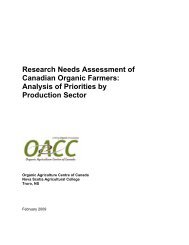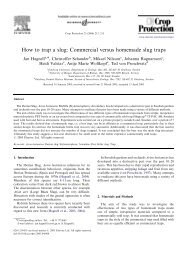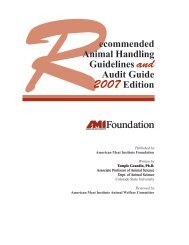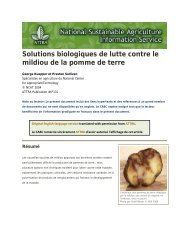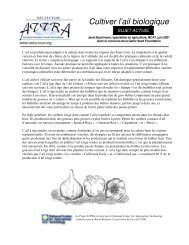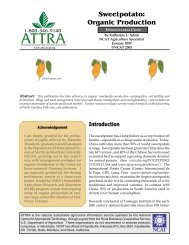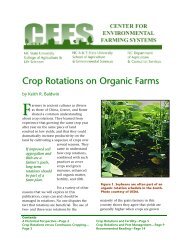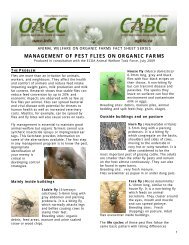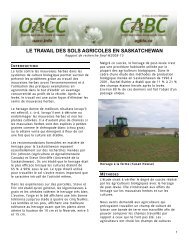Create successful ePaper yourself
Turn your PDF publications into a flip-book with our unique Google optimized e-Paper software.
Planting mixtures of cover crops can help afarmer to use the allelopathic potential ofthe cover crops to suppress weeds. Allelopathicsuppression of weeds depends onboth the cover crop and the weed. There<strong>for</strong>e,a broader spectrum of weed controlmay be possible by growing a mixture ofcover crops, with each species contributingallelopathic activity towards specific weedspecies (Creamer and Bennett, 1997).Mixtures of cover crops can also be plantedto influence insect populations. Species thatmay not produce much biomass or biomassN may be included in mixtures to attractbeneficial insects into the cropping system.Measuring <strong>Cover</strong> Crop Nitrogen. Toensure that cash crops receive enoughnutrients, farmers must accomplish thesecalculations in this sequence:1. Determine the biomass produced.2. Determine the nutrient levels in thatbiomass.3. Predict how quickly the biomass willdecompose, releasing nutrients <strong>for</strong> cashcrops.4. Calculate whether additional nutrientsare required <strong>for</strong> the desired crop yields.<strong>Cover</strong> Crop TipCalculating the nutrient levels released bygreen manures <strong>for</strong> a subsequent cash cropnormally requires three measurements:• The amount of biomass (dry weight).• The nutrient composition of the covercrop.• The decomposition rate of the cover cropduring the cash cropping season.To estimate yield, take cuttings from severalareas in the field. Dry and weigh the samples.Use a yardstick or metal frame of knowndimensions and clip the plants at ground levelwithin the known area. Dry the samples in anoven at about 140°F <strong>for</strong> 24 to 48 hours untilthey are crunchy dry. Use the followingequation to determine per acre yield of drymatter:Yield (lb/acre) =Total weight of dried samples (lb) X43,560 sq ftArea (sq ft) sampled 1 acreFor example, two 3 feet by 3 feet (9 sq ft or 1 sqyd) samples weigh 2.5 pounds. The driedbiomass yield equals:Yield (lb/acre) =2.5 lbX43,560 sq ft = 6,050 lb/acre.18 sq ft 1 acreThough not as accurate, yield can be estimatedfrom the height of the cover crop and thepercentage of ground it covers. At 100 percentground coverage and a 6-inch height, mostnonwoody legumes contain roughly 2,000pounds per acre of dry matter. For each additionalinch, add 150 pounds.For example, a hairy vetch cover crop is 18inches tall and has 100 percent groundcoverage. The first 6 inches of dry biomassweighs roughly 2,000 pounds. The 12additional inches of growth weighs 150 poundsper inch. The additional weight is:12 X 150 = 1,800 lb,and the total weight of the cover crop drymatter is:2,000 + 1,800 = 3,800 lbIf the stand has less than 100 percent groundcoverage, multiply the total weight by thepercentage of ground covered, represented as adecimal number (the percentage divided by100). If the percentage of ground covered in theexample above is 60 percent, then the weightof the dry matter is:3,800 X 0.60 (60/100) = 2,280 pounds of drybiomass (Adapted from Sarrantonio, 1998)<strong>Organic</strong> Production—<strong>Cover</strong> <strong>Crops</strong> <strong>for</strong> <strong>Organic</strong> <strong>Farms</strong> 9



